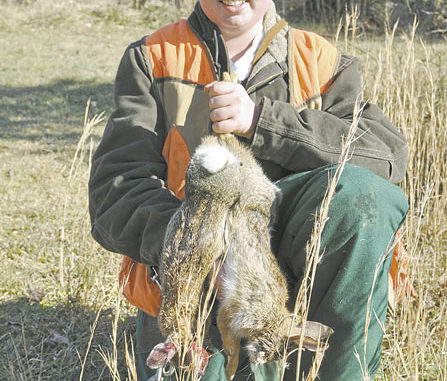
Harold Langdon trains some of the top rabbit dogs in North Carolina; what he’s learned will make you a better hunter.
One day last January, Harold Langdon sat on a stump last January inside a cutover that was part of a large deer lease.
“Need to take a rest,” said Langdon, 74. “And besides, the dogs are running that rabbit this way. Maybe he’ll pass close by enough that we can get a shot.”
The temperature that day had started well below freezing, with a blanket of frost covering the ground at daylight.
Langdon, the designated hunt-master, had opened the day’s festivities with a few words of wisdom for a dozen hunters standing in a semi-circle near pickup trucks that held three dozen beagles ready to leap from tailgates and begin another day’s adventure.
“I don’t want anyone to get shot, nor any of the dogs,” said Langdon, owner of Hillcrest Hounds of Smithfield (919-934-1960). “We also want to eat what we shoot, so if anyone shoots one of my dogs, he has to eat him — after he pays me.
“One dog I own is worth $15,000, but the most expensive one I have here today costs $10,000. The others run about $500 each.
“So be sure what you’re aiming at before you pull the trigger.”
The hunters received Langdon’s message with a mixture of quiet laughter and understandable concern.
It’s not difficult to lure Langdon away from his home. All he needs is an invitation to a field trial — or to hunt rabbits. That’s what happened last January when several Alamance County hunters got together and one of them, Eric White, invited Langdon to hunt near Saxapahaw.
The property, several thousand acres in the southern part of the county, is owned and managed by a deer-hunting club. As far as small-game hunting goes, it lies undisturbed until after North Carolina’s whitetail season ends Jan. 1.
That’s when one of the club’s members, Jim Copland, invites local hunters with top-of-the-line beagle packs to chase cottontails.
Many of the invited hunters own the best dogs money can buy, and that’s how Langdon, a champion beagle trainer, wangled an invitation.
“I’ve taken Eric (White) on a lot of hunts, so I kidded him that he needed to invite me sometime,” said Langdon, a former U.S. Navy pilot and navigator who later became an insurance executive. “I’ve never been here before, but this looks like a really good place for rabbits.”
Langdon is in the second rabbit-hunting phase of his life. When he was young, his father, who farmed tobacco in Franklin County, wasn’t keen on activities that didn’t add to the family income, so several years passed before Langdon got his first set of rabbit dogs.
Then, after he left home for college — followed by service in the military — Langdon didn’t have time to hunt nor a place to keep beagles. After making his fortune in the life-insurance business, he decided to chuck that occupation and return to his first love: hunting rabbits and raising beagles.
“My father wasn’t a hunter,” he said. “He believed in working his farms all the time. I remember asking him when I was about nine years old for a beagle so I could go hunting. His answer was ‘What have you lost?’”
Langdon said his father finally relented a year later and replaced a radio with a .410 shotgun as a Christmas present.
“I started rambling the fields and woods,” he said, “then I started begging my dad again to get me some beagles, and he finally bought me four dogs. It was hard to find me (at home) after that.”
After graduating from East Carolina University, Langdon was about to be drafted, and on the advice of his father-in-law, a lieutenant-colonel in the U.S. Army, Langdon entered Officers Candidate School and was trained as a Navy pilot. He later became a navigator, flying missions to Alaska from his base in Hawaii.
“When I was in college, my dad called me up and said he wasn’t going to feed my beagles, so I sold them,” he said. “After I got out of the Navy, I started in the insurance business in Honolulu,” he said. “Finally, the company asked me to start a branch office in Fayetteville. Can you believe I was dumb enough to leave Honolulu for Fayetteville? But I did.”
Langdon worked in insurance for 17 years and made enough money to buy a home, boats, play golf and have a beach house, but something still was missing.
“I had to work really hard, so I didn’t have time for hunting or beagles,” he said, “even though I’d made plenty of money.”
One day at the golf course, Langdon decided he’d had enough of the insurance world.
“I wanted to do something I enjoyed,” he said. “I decided I wanted to hunt again, and if I did that, I wanted beagles. So I made a list of things to do — it meant buying some land for a place to keep my dogs.”
Langdon purchased a rental house in Johnston County, built some dog pens and allowed a family to live rent-free in exchange for feeding and caring for his beagles. That was 28 years ago.
“I’ve been involved in training beagles and rabbit hunting ever since,” he said.
Habitat remains the key for having good numbers of rabbits, Langdon said. He has several friends who own large tracts of land, and they invite him to bring his beagles to chase cottontails.
“It’s hard to find the right conditions to hunt rabbits,” he said, “but cutovers are ideal places. What you need is thick underbrush that’s close to the ground so rabbits will have good cover and protection. If you don’t have that, foxes, coyotes and other predators will eat them. They also need cover to keep the hawks and owls from getting them.
“Other great places for rabbits are farms with land in the CRP (Conservation Reserve Program),” he said. “They let their land grow up, and it provides good rabbit habitat.
“It’s kind of like that old story of B’rer Rabbit and the briar patch. If you’ve got briars close to the ground, it helps rabbits survive. That’s where you’ll find the majority of your rabbits today, because everything wants to eat them. Coyote numbers are growing, plus hawks are (federally) protected, and owls work on them at night. Even possums and raccoons will eat baby rabbits they find in the nest, along with crows.”
Fire ants also have become a major problem for rabbits, he said.
“Fire ants are spreading across North Carolina, and if a female (doe) rabbit makes a nest and the fire ants find it in the spring, all you’ll have is a bunch of dead baby rabbits because they’ll sting and kill them all of them,” he said.
Langdon has three enclosures — “rabbit pens” — that he uses to train his beagles. He sprays the pens each year to control fire ants and ticks. In fact, rabbit pens are Langdon’s real secret to training beagles.
“Without pens and shock-control collars, it’d be pretty difficult to train beagles,” he said.
Langdon rarely takes a shotgun with him these days, preferring instead to work his dogs for other hunters.
“You really can’t have a good hunt if more than one person is working the dogs,” he said. “If two people are hollering at them when they jump a rabbit, they’ll get confused. So I just like to work the dogs and let others do the shooting.”

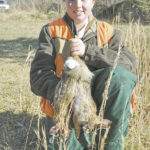
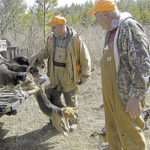
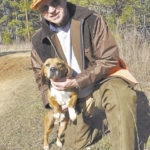
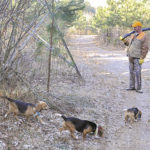
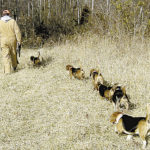



Be the first to comment